It's been almost a month since our last blog! This already tells a lot about how desperate our biodiversity situation is at this time of year. For us, lovers of forest & mountain birds, the advent of the cold season is always harsh. Our beloved Dinaric forests become quite empty, wildlife is scarce and it gets increasingly difficult to find some decent bird diversity in the cold Notranjska and Karst regions. Nevertheless at the end of November we enjoyed the last few sunny and dry days in the forests of Snežnik, before the arrival of the first snow. Our main target was, as very often, the
White-backed Woodpecker Dendrocopos leucotos ssp.
lilfordi, a species we are currently studying with particular interest. But finding a White-back at the end of autumn is not easy at all, however it's still nice to hike in remote forests in search of its feeding signs, old nest-holes, possible territories ect. At the end of an excellent sunny and windless day we finally managed to observe a White-back briefly, whereas searching for its rare cousin, the Three-toed Woodpecker
Picoides tridactylus in a nearby stand of old conifers didn't prove productive.
 |
In White-back's habitat.
|
 |
Old feeding signs of White-backed Woodpecker on a fallen beech trunk.
|
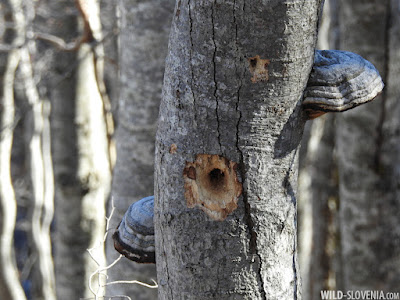 |
Fresh feeding signs of White-back on standing beeches.
|
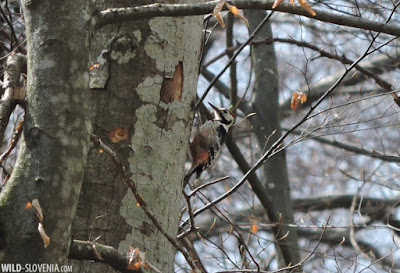 |
White-backed Woodpecker Dendrocopos leucotos ssp. lilfordi
|
 |
Christmas Rose Helleborus niger just about to bloom.
|
 |
One hell of a view over the Snežnik plateau.
|
 |
Alpine Juniper Juniperus alpina on a limestone outcrop in the middle of the forest.
|
 |
A centenary beech Fagus sylvatica, contorted by the harsh weather & growing contitions.
|
 |
Sinkholes (sometimes rather large) are a typical feature of the karstic Snežnik plateau.
|
 |
Quite possibly a Brown Bear's den.
|
Fast forward several weeks and we are on the 12th of December. Our White-backed Woodpecker search continues, but this time the Dinaric mountains are covered in a thick layer of snow. On this sunny and bitterly cold day we wanted to enjoy a hike in the fresh snow, but also combine it with a visit to a White-back's territory. This time we chose the forests on the Nanos plateau, where colleagues came across some territorial pairs last spring. Winter (with snow cover) is even worse for searching White-backs, but nevertheless we gave it a try. The hike was very nice, most of the time walking in a layer of 25 cm of snow, but with very few birds around, as usual in this season. We didn't see any White-backed Woodpecker this time, however we came across several fresh & old feeding signs, so it will certainly be worth to investigate the area in spring. Nevertheless another bird managed to get us excited at the end of the day - a fantastic Nutcracker Nucifraga caryocatactes landing on the top of a silver fir and calling loudly at us. Despite the species being a widespread breeder in mountain conifer forests across Slovenia, it has become rather scarce in the last decade and getting close views is never easy.



Nutcracker Nucifraga caryocatactes (turn volume on!)
 |
Treecreeper Certhia familiaris
|
 |
White-back's territory in the forest on the Nanos plateau.
|
 |
Fresh feeding signs of White-backed Woodpecker.
|
 |
Measuring trees with feeding signs.
|
 |
Tinder Fungus Fomes fomentarius
|
 |
Another lovely bracket fungus.
|
 |
Tree Lungwort Lobaria pulmonaria (lichen)
|
 |
Some early Hazel Corylus avellana catkins.
|
 |
Footprints of (possibly) Pine Marten Martes martes leading to a hole under a rock.
|
 |
Winter wonderland.
|
 |
Selfie in the first snow.
|
 |
Snow on the Dinaric ridge of Trnovski gozd, seen from the Karst.
|
 |
Mt. Krn (2244 m) in the Julian Alps from the Karst.
|
 |
Firecrest Regulus ignicapilla in the garden.
|
 |
Last flock of Common Cranes Grus grus of the season (?) over the house.
|
Wetlands are probably the most productive areas for birding at this time of year. However, despite some decent cold temperatures over central and northern Europe, Škocjanski zatok failed to impress us so far in terms of numbers and diversity. This was probably due to the low water levels maintained throughout autumn due to some extensive maintenance works in the freshwater marsh. Now the water is back and hopefully, with it will come more birds. So far the most interesting sightings have been an Avocet Recurvirostra avosetta in the lagoon (first winter record for the site, thanks to Daniel Bosch for the find!), a lingering Great Grey Shrike Lanius excubitor (seen daily from the office), the first Fieldfare Turdus pilaris of the season, a few Lapwings Vanellus vanellus, Grey Plover Pluvialis squatarola, small numbers of Penduline Tits Remiz pendulinus and the first returning Greylag Geese Anser anser. Wildfowl numbers are slowly on the rise, but as we said, we'll probably need to have some more cold weather for additional diversity & numbers. Weekly bird reports from Škocjanski zatok can be followed on FB & website.
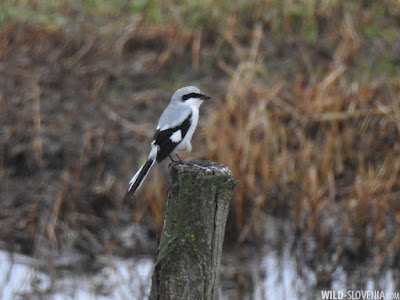 |
| Great Grey Shrike Lanius excubitor |
 |
| Fieldfare Turdus pilaris |
 |
| Penduline Tit Remiz pendulinus |
 |
| Greylag Goose Anser anser |
Given the general lack of birding satisfactions, two weekends ago (4th Dec) we decided to make a visit to the neighbours, in the rich lagoons of northeastern Italy. It was also a good excuse to catch up with some friends and do some birding together. The main attraction were two Snow Buntings Plectrophenax nivalis on the northern shores of the Grado lagoon near Aquileia. Despite the two birds being extremely unshy (watched them down to 1,5 metres), an approaching car flushed them away, making them disappear forever over the lagoon. A brief, but nevertheless pleasing encounter with this rare winter visitor (last time we saw the species was here). About a week later one Snow Bunting was also found in the Štajerska region in Slovenia and perhaps more will be sighted this winter. Later in the day we also visited the Valle Cavanata wetland near Grado where we enjoyed a group of Flamingos Phoenicopterus roseus, a rather unseasonal flock of 31 Spoonbills Platalea leucorodia, the first Goldeneyes Bucephala clangula of the season, as well as other commoner waterbirds that we are not used to see in such abundance at Škocjanski zatok: Pintail Anas acuta, Lapwing Vanellus vanellus, Grey Plover Pluvialis squatarola, carpets of Dunlins Calidris alpina & Spotted Redshanks Tringa erythropus and so on. In the late afternoon we also made a stop to the arable fields just outside Isola della Cona Nature Reserve, where a large flock of White-fronted Geese Anser albifrons was feeding. Scanning through the flock, looking for the 2 Lesser White-fronted Geese Anser erythropus present within, we counted 3500 individuals, but found no rarities. Only a few days later 2 Red-breasted Geese Branta ruficollis turned up in the same flock! Therefore we'll probably need to pay another visit to this area later in the season.


 |
Snow Bunting Plectrophenax nivalis (lower pic by Paolo Utmar).
|
 |
| Goldeneye Bucephala clangula |
 |
| Flamingo Phoenicopterus roseus |
 |
| Lapwing Vanellus vanellus |
 |
| Dunlin Calidris alpina |
 |
The mudflats by the Isonzo/Soča rivermouth and Trieste on the opposite site of the gulf.
|
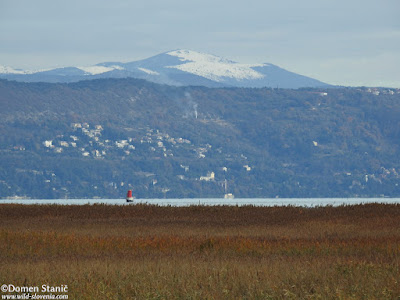 |
Reedbed by the Isonzo/Soča rivermouth with Mt. Vremščica (Slovenia) in the distance.
|
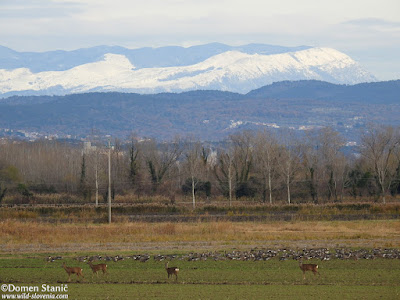 |
White-fronted Geese Anser albifrons with snow-covered Nanos in the back.
|
 |
| White-fronted Geese Anser albifrons |
 |
White-fronted Geese Anser albifrons photo-bombed by Roe Deer Capreolus capreolus.
|
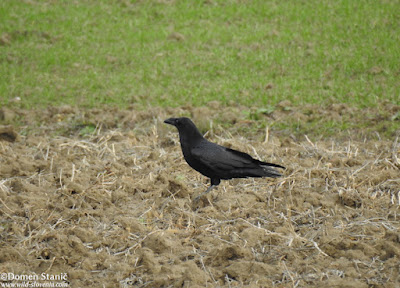 |
Raven Corvus corax in the fields - a once-unusual, but now rather common sight.
|
If for several reasons (limited time, lots of work, lack of motivation...) we'll fail to post new content to the blog in the future, you can also find us on
Twitter - a place where it is somehow easier to post small, short and regular updates from our field activities. So if you're a fan of this blog and would like to stay updated, make sure to follow
Domen's profile. Here or there, see you around!




















































